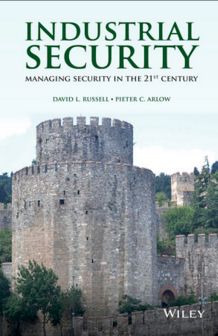Author: David L Russell and Pieter C Arlow
ISBN No: 978-1-119-02842-0
Review date: 24/04/2024
No of pages: 224
Publisher: Wiley
Publisher URL:
https://www.wiley.com/en-gb/Industrial+Security%3A+Managing+Security+in+the+21st+Century-p-9781119028420
Year of publication: 27/07/2015
Brief:
Industrial Security: Managing Security in the 21st Century is not quite as wide-ranging as the title may suggest, and the book cover while handsome does not really tell you what the book’s subject is; for the text covers the securing of industrial plant, such as oil refineries and ports, chemical works and power plants. The book is also directed at countries where the threats and the defence forces for such plants may be armed (though that can include the UK, as the Civil Nuclear Constabulary covering nuclear power stations is 100 per cent armed).
For example, early on the book describes security at a Saudi Arabian oil works as visible deterrence at the perimeter, of ‘security checks, and a highly visible security presence, and after the security checkpoints, there are armed defensive positions with automatic weapons that are rapidly accessible from the security positions’. The guard force has ‘two‐way radios, side arms, and the aura of an armed presence that could repel an attacker.’ The authors also give a Middle East example of the value of layers of security to impose delay on attackers: Two terrorist suicide bombers in separate trucks coordinated their attack on the facility. The first one made it past the outer perimeter, but could not penetrate into the middle perimeter. He started ramming his truck laden with explosives against the fence in an effort to batter it down. The terrorist was so focused on his own activities and failures that, in frustration, he detonated his truck bomb just as the second terrorist drove up to the fence. The resulting explosion took out both trucks, but aside from a hole in the ground where the fence was and some flying debris, the facility was undamaged.”
Sensibly it begins with definitions and talks in terms of risk assessment and risk management (not the same things, as the authors properly point out).
As they state early on, there have been many cases of refineries with large tank storage that have had spills that led to fires and explosions in the tank farms. “The point is that industry has regular firefighting drills, but when do they have security and other disaster drills? These are stress tests of the system, and the answer is, unfortunately, not so frequently. People stay sharp when they are challenged and regularly exercised on topics of concern, and increased awareness benefits everyone in the plant.” Security and risk, then, are everyone’s business.
By considering plant security in terms of risk, it can seek a place at the ‘table’ with the safety and hazard prevention of a port or other site handling hazardous materials. This is not news to a security professional, and nor will be the chapter on cyber security, though it’s to the credit of the authors that they include cyber at all, for the port and maritime and industrial sectors are notorious for being behind on cyber-security.
Something else worth pointing out; the sheer size and breadth of such sites, sprawling whether in terms of perimeters or length of pipeline, that demand size and breadth of physical security. And if sites have developed over decades (like campuses tend to and indeed cities generally), that makes keeping the perimeters and layers up to date, and the fence patched, jobs in themselves (and guards might also have routine traffic management duties).
This book is, then, aimed at and suited for high-security sites typically in the Middle East that may face terrorist attack; besides sites in the English-speaking world where the risks may include disputing unions and workers, and complaining local residents, and environmentalist protesters, who may be behind vandalism, intrusion and sabotage.
Despite the strangely inaccurate cover image, and the rather steep price for the number of pages, at least part of the title is completely correct; the book definitely covers security as it will have to be done in the 21st century, as there’s no sign of an end to either large, hazardous industrial sites, and the varied threats to them.










